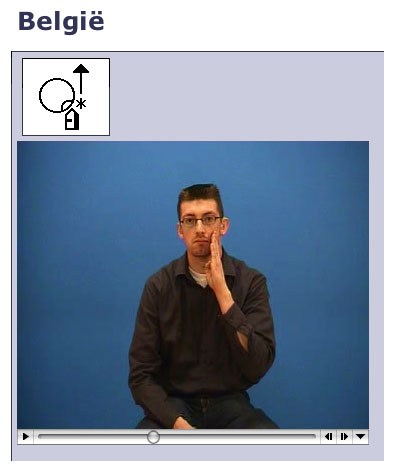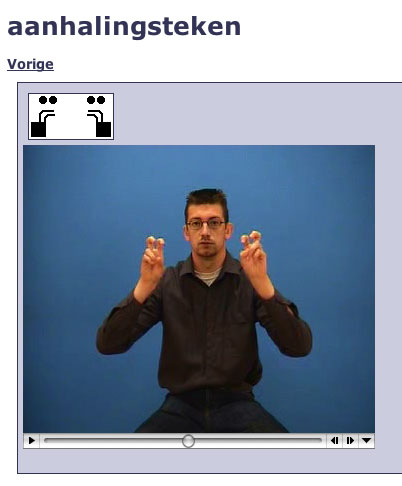A
few years ago the project The Deaf community
in Flanders: evaluation, sensitisation and
standardization of Flemish Sign Language
was set up. It formed part of the PBO (Programma
Beleidsgericht Onderzoek — Programme
Policy-oriented Research) of the Ministry
of the Flemish Community (98/20/129). On
the basis of the lexicographic part of this
research project a sign language dictionary
Dutch-Flemish Sign Language was created
in book form. It is about to be published
with Fevlado-Diversus.
Moreover, the project Sociolinguistic
Research of Flemish Sign Language, carried
out at Ghent
University and financed by the BOF (Bijzonder
Onderzoeksfonds — Special Research
Fund) (B/00056 — BOF/2-4/BOF2002),
made it possible to create a more elaborate,
electronic version of this dictionary. The
website you are now visiting is of high
scholarly and innovative value, but also
meets several other needs. Both projects
set out to develop a tool — being
a sign language dictionary in both book
and electronic form ? to support the education
of the lexicon of Flemish Sign Language.
This goal is now partly achieved.
The
linguistic part of the research took place
at Ghent University, in cooperation with
the Department of Germanic Languages —
CLIN (Centrum voor Linguïstiek —
Centre for Linguistics) of the Free University
of Brussels. It was conducted by supervisor
Prof. dr. M.
Van Herreweghe, English Department —
Ghent University and co-supervisor Prof.
dr. M.
Vermeerbergen, Department of Germanic
Languages CLIN, Free University of Brussels.
The
first part of the research was carried out
by Kristof
De Weerdt and Eline Vanhecke, who started
working on it in October 1999. In June 2003
Katrien
Van Mulders took Eline's place. The
development of the dictionary required the
cooperation of a Deaf native signer and
a hearing Dutch-speaking linguist, since
native speakers/users of both languages
are necessary when creating a translating
dictionary.
The
electronic version of the dictionary was
developed by Steven
Aerts and Bart
Braem, who study computer sciences at
the University of Antwerp. They were supervised
by Prof. Jan
Paredaens, Philippe
Michiels, Nele
Dexters and Jan
Adriaenssens.
Until
now Flanders had no dictionary of Flemish
Sign Language, not in book form, nor on
the internet. From various angles, however,
there was a serious need of this tool. Teachers
in the Flemish deaf schools cannot consult
any dictionary when they do not know how
to translate a certain Dutch word into Flemish
Sign Language. Nor can the teachers who
work at the sign language interpreter schools.
The dictionary is also highly needed by
various organisations (e.g. Fevlado (Federatie
van Vlaamse Dovenorganisaties — Federation
of Flemish Deaf Organisations)) that set
up sign language courses throughout Flanders
and several CVO's (Centrum voor Volwassenenonderwijs
— Centre for Adult Education). It
will in fact be interesting for all those
who come in touch with Flemish Sign Language
one way ore another.

To
be able to elicit the signs that are currently
included in the dictionary, lists of priority
terms were developed. These lists contain
the 'basic' Flemish Sign Language lexicon
and include general themes, like family,
health, colours, clothing,
occupations, etc.
The
signs were elicited from voluntary informants,
who formed regional working parties. Composing
five such regional working parties (one
in each Flemish province) was necessary,
since currently there exist five regional
sign language variants in Flanders. These
variants developed in the Flemish deaf schools
and the regions in which they are used more
or less correspond with the five Flemish
provinces: Antwerp, East-Flanders, Flemish-Brabant,
Limburg and West-Flanders. Each working
party consisted of about 6 Deaf informants,
who all met the following demands: between
20 and 50 years of age, having a thorough
command of the studied sign language variant
and using it as their first language, being
an active member of the Flemish Deaf community
and having received education in a deaf
school. Both men and women were involved
in the research.
In
each group one native signer was allowed
to look at the lists of priority terms and
was in charge of eliciting the signs by
means of eliciting material and of filming
the conversations. The informants themselves
did not get to see the Dutch words, in order
to avoid possible interference from Dutch.
The
research eventually resulted in about 90
hours of recorded language data (an average
of 1 hour and a half per session, per region).
This data was inventorised, transcribed
and analysed linguistically. The signs were
then filmed again to be able to include
them in this dictionary.
The
dictionary currently contains over 6000 signs
from Flemish Sign Language, but is still being
elaborated. The signs can be read through
SignWriting
and can be seen as moving pictures. SignWriting
is an American transcription system invented
by Valerie Sutton and the Deaf
Action Committee (DAC). It allows for
a very visual rendering of the signs, using
symbols to represent the handshapes, movements,
facial expressions, and body shifting. We
chose to render the signs in SignWriting as
well as moving pictures, because the former
can easily and effectively be used in scientific
research. It also serves various other goals:
it can be used to teach new signs in the deaf
schools, as well as for writing down texts
in VGT.
You
can search the electronic dictionary in two
directions. You can look for the VGT translation
of a Dutch word, as well as look up the Dutch
counterpart of a Flemish sign. It is also
possible to differentiate between the various
regional variants. You can look for signs
that are used solely in the West-Flemish variant,
or in both the West-Flemish and Antwerp variant,
etc... The region(s) where the sign is used,
appear(s) on the right-hand side of the screen,
next to the sign.

When
developing this dictionary we intended to
render the basic Flemish Sign Language
lexicon as accurately and completely as
possible. We did not aim at choosing the
best suitable sign for each Dutch term,
but instead wanted to include all existing
sign language variants that are currently
used in Flanders. We took into account all
lexical and regional variation that was
recorded during the collection of the data.
However,
due to the relatively small number of informants
(about 6 per province) and the fact that
we are dealing with a random indication
of Flemish Sign Language, you have to take
into account that it is simply impossible
to record all existing signs. It is possible
that you see Flemish signers use signs that
are not included here. They are by no means
worse than or inferior to the signs that
can be found in the dictionary. But you
cannot expect the informants to know all
signs used in their region or to have produced/remembered
all of them during the meetings. This is,
after all, a first basic dictionary. Further
research also remains necessary to expose
the differences between the various variants
(concerning register, age, context, gender,
...). Nevertheless, we assume this dictionary
to contain the basic Flemish Sign Language
lexicon. Moreover, thanks to this electronic
version it is possible to constantly add
newly recorded signs. The included lexicon
will therefore continuously be elaborated
and — in time — become more
complete.

In
this dictionary the Dutch word for an occupation
(e.g. carpenter, cashier, ...) is always accompanied
by the sign used to refer to that occupation.
Sometimes that sign is followed or - to a
lesser extent - preceded by the sign PERSON,
thus creating a compound sign. However, in
day-to-day conversation these signs - both
with and without PERSON - are hardly ever
used. Instead Flemish signers produce something
like 'WORKS IN A BANK' for BANKER or 'WORKS
IN A SHOP' for CASHIER. This construction
can of course not be used for every occupation
(e.g. hairdresser or baker), but it is used
quite frequently. Our informants' sign language
use was probably influenced by the situation
(presence of a camera, eliciting material,
?) when the occupation signs were elicited,
but this is impossible to avoid. To make a
difference between for example a male and
a female police officer (in Dutch AGENT and
AGENTE respectively), Flemish signers will
add MAN or WOMAN to the sign POLICE OFFICER.
This happens with a lot of occupations, e.g.
nurse (in Dutch verpleger vs. verpleegster)
doctor (in Dutch dokter vs. dokteres),
...

Dutch
— like many other languages —
has specific terms to denote the female, male
and young of a certain animal species (e.g.:
sheep ('schaap'): ram ('ram'), ewe ('ooi'),
lamb ('lam'); cattle ('rund'): bull ('stier'),
cow ('koe'), calf ('kalf')). Flemish Sign
Language also has specific signs for these
animals, but they are hardly ever used. Usually
the reference is made as follows: SHEEP +
MAN, SHEEP + WOMAN, SHEEP + SMALL.
Katrien
Van Mulders
katrien_vanmulders@yahoo.com
Universiteit
Gent
October 2004
![]()




























